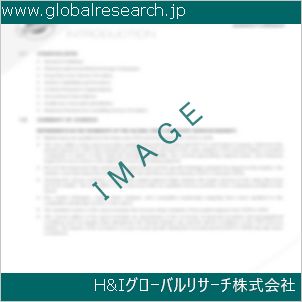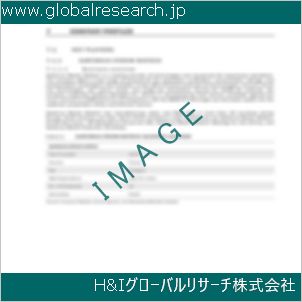Table of Contents
1 Industry Overview of Leadarsenate
1.1 Definition and Specifications of Leadarsenate
1.1.1 Definition of Leadarsenate
1.1.2 Specifications of Leadarsenate
1.2 Classification of Leadarsenate
1.3 Applications of Leadarsenate
1.3.1 Nuclear Application
1.3.2 Non-Nuclear Application
1.4 Industry Chain Structure of Leadarsenate
1.5 Industry Overview and Major Regions Status of Leadarsenate
1.5.1 Industry Overview of Leadarsenate
1.5.2 Global Major Regions Status of Leadarsenate
1.6 Industry Policy Analysis of Leadarsenate
1.7 Industry News Analysis of Leadarsenate
2 Manufacturing Cost Structure Analysis of Leadarsenate
2.1 Raw Material Suppliers and Price Analysis of Leadarsenate
2.2 Equipment Suppliers and Price Analysis of Leadarsenate
2.3 Labor Cost Analysis of Leadarsenate
2.4 Other Costs Analysis of Leadarsenate
2.5 Manufacturing Cost Structure Analysis of Leadarsenate
2.6 Manufacturing Process Analysis of Leadarsenate
3 Technical Data and Manufacturing Plants Analysis of Leadarsenate
3.1 Capacity and Commercial Production Date of Global Leadarsenate Major Manufacturers in 2023
3.2 Manufacturing Plants Distribution of Global Leadarsenate Major Manufacturers in 2023
3.3 R&D Status and Technology Source of Global Leadarsenate Major Manufacturers in 2023
3.4 Raw Materials Sources Analysis of Global Leadarsenate Major Manufacturers in 2023
4 Capacity, Production and Revenue Analysis of Leadarsenate by Regions, Types and Manufacturers
4.1 Global Capacity, Production and Revenue of Leadarsenate by Regions 2019-2024
4.2 Global and Major Regions Capacity, Production, Revenue and Growth Rate of Leadarsenate 2019-2024
4.3 Global Capacity, Production and Revenue of Leadarsenate by Types 2019-2024
4.4 Global Capacity, Production and Revenue of Leadarsenate by Manufacturers 2019-2024
5 Price, Cost, Gross and Gross Margin Analysis of Leadarsenate by Regions, Types and Manufacturers
5.1 Price, Cost, Gross and Gross Margin Analysis of Leadarsenate by Regions 2019-2024
5.2 Price, Cost, Gross and Gross Margin Analysis of Leadarsenate by Types 2019-2024
5.3 Price, Cost, Gross and Gross Margin Analysis of Leadarsenate by Manufacturers 2019-2024
6 Consumption Volume, Consumption Value and Sale Price Analysis of Leadarsenate by Regions, Types and Applications
6.1 Global Consumption Volume and Consumption Value of Leadarsenate by Regions 2019-2024
6.2 Global and Major Regions Consumption Volume, Consumption Value and Growth Rate of Leadarsenate 2019-2024
6.3 Global Consumption Volume and Consumption Value of Leadarsenate by Types 2019-2024
6.4 Global Consumption Volume and Consumption Value of Leadarsenate by Applications 2019-2024
6.5 Sale Price of Leadarsenate by Regions 2019-2024
6.6 Sale Price of Leadarsenate by Types 2019-2024
6.7 Sale Price of Leadarsenate by Applications 2019-2024
6.8 Market Share Analysis of Leadarsenate by Different Sale Price Levels
7 Supply, Import, Export and Consumption Analysis of Leadarsenate
7.1 Supply, Consumption and Gap of Leadarsenate 2019-2024
7.2 Global Capacity, Production, Price, Cost, Revenue, Supply, Import, Export and Consumption of Leadarsenate 2019-2024
7.3 USA Capacity, Production, Price, Cost, Revenue, Supply, Import, Export and Consumption of Leadarsenate 2019-2024
7.4 EU Capacity, Production, Price, Cost, Revenue, Supply, Import, Export and Consumption of Leadarsenate 2019-2024
7.5 China Capacity, Production, Price, Cost, Revenue, Supply, Import, Export and Consumption of Leadarsenate 2019-2024
7.6 Japan Capacity, Production, Price, Cost, Revenue, Supply, Import, Export and Consumption of Leadarsenate 2019-2024
8 Major Manufacturers Analysis of Leadarsenate
8.1 Manufacturer One
8.1.1 Company Profile
8.1.2 Product Picture and Specifications
8.1.2.1 Type I
8.1.2.2 Type II
8.1.2.3 Type III
8.1.3 Capacity, Production, Price, Cost, Gross and Revenue
8.1.4 Contact Information
8.2 Manufacturer Two
8.2.1 Company Profile
8.2.2 Product Picture and Specifications
8.2.2.1 Type I
8.2.2.2 Type II
8.2.2.3 Type III
8.2.3 Capacity, Production, Price, Cost, Gross and Revenue
8.2.4 Contact Information
8.3 Manufacturer Three
8.3.1 Company Profile
8.3.2 Product Picture and Specifications
8.3.2.1 Type I
8.3.2.2 Type II
8.3.2.3 Type III
8.3.3 Capacity, Production, Price, Cost, Gross and Revenue
8.3.4 Contact Information
8.4 Manufacturer Four
8.4.1 Company Profile
8.4.2 Product Picture and Specifications
8.4.2.1 Type I
8.4.2.2 Type II
8.4.2.3 Type III
8.4.3 Capacity, Production, Price, Cost, Gross and Revenue
8.4.4 Contact Information
8.5 Manufacturer Five
8.5.1 Company Profile
8.5.2 Product Picture and Specifications
8.5.2.1 Type I
8.5.2.2 Type II
8.5.2.3 Type III
8.5.3 Capacity, Production, Price, Cost, Gross and Revenue
8.5.4 Contact Information
…
9 Marketing Trader or Distributor Analysis of Leadarsenate
9.1 Marketing Channels Status of Leadarsenate
9.2 Traders or Distributors with Contact Information of Leadarsenate by Regions
9.3 Ex-work Price, Channel Price and End Buyer Price Analysis of Leadarsenate
9.4 Regional Import, Export and Trade Analysis of Leadarsenate
10 Industry Chain Analysis of Leadarsenate
10.1 Upstream Major Raw Materials Suppliers Analysis of Leadarsenate
10.1.1 Major Raw Materials Suppliers with Contact Information Analysis of Leadarsenate
10.1.2 Major Raw Materials Suppliers with Supply Volume Analysis of Leadarsenate by Regions
10.2 Upstream Major Equipment Suppliers Analysis of Leadarsenate
10.2.1 Major Equipment Suppliers with Contact Information Analysis of Leadarsenate
10.2.2 Major Equipment Suppliers with Product Pictures Analysis of Leadarsenate by Regions
10.3 Downstream Major Consumers Analysis of Leadarsenate
10.3.1 Major Consumers with Contact Information Analysis of Leadarsenate
10.3.2 Major Consumers with Consumption Volume Analysis of Leadarsenate by Regions
10.4 Supply Chain Relationship Analysis of Leadarsenate
11 Development Trend of Analysis of Leadarsenate
11.1 Capacity, Production and Revenue Forecast of Leadarsenate by Regions and Types
11.1.1 Global Capacity, Production and Revenue of Leadarsenate by Regions 2024-2029
11.1.2 Global and Major Regions Capacity, Production, Revenue and Growth Rate of Leadarsenate 2024-2029
11.1.3 Global Capacity, Production and Revenue of Leadarsenate by Types 2024-2029
11.2 Consumption Volume and Consumption Value Forecast of Leadarsenate by Regions, Types and Applications
11.2.1 Global Consumption Volume and Consumption Value of Leadarsenate by Regions 2024-2029
11.2.2 Global and Major Regions Consumption Volume, Consumption Value and Growth Rate of Leadarsenate 2024-2029
11.2.3 Global Consumption Volume and Consumption Value of Leadarsenate by Types 2024-2029
11.2.4 Global Consumption Volume and Consumption Value of Leadarsenate by Applications 2024-2029
11.3 Supply, Import, Export and Consumption Forecast of Leadarsenate
11.3.1 Supply, Consumption and Gap of Leadarsenate 2024-2029
11.3.2 Global Capacity, Production, Price, Cost, Revenue, Supply, Import, Export and Consumption of Leadarsenate 2024-2029
11.3.3 USA Capacity, Production, Price, Cost, Revenue, Supply, Import, Export and Consumption of Leadarsenate 2024-2029
11.3.4 EU Capacity, Production, Price, Cost, Revenue, Supply, Import, Export and Consumption of Leadarsenate 2024-2029
11.3.5 China Capacity, Production, Price, Cost, Revenue, Supply, Import, Export and Consumption of Leadarsenate 2024-2029
11.3.6 Japan Capacity, Production, Price, Cost, Revenue, Supply, Import, Export and Consumption of Leadarsenate 2024-2029
12 New Project Investment Feasibility Analysis of Leadarsenate
12.1 New Project SWOT Analysis of Leadarsenate
12.2 New Project Investment Feasibility Analysis of Leadarsenate
13 Conclusion of the Global Leadarsenate (CAS 3687-31-8) Industry 2024 Market Research Report
| ※参考情報 ヒ酸鉛(Lead arsenate、CAS番号3687-31-8)は、主に農業および化学産業における殺虫剤として使用される化合物です。この化合物は、鉛(Pb)とヒ素(As)が結合したもので、化学式はPb(H₃AsO₄)₂で示されます。 ヒ酸鉛の特徴としては、その高い毒性が挙げられます。特に、昆虫に対して強力な影響を持つため、種子や果物の害虫駆除において広く利用されてきました。しかし、その使用に伴う健康リスクや環境への影響から、現在では多くの国でその使用が制限または禁止されています。このため、ヒ酸鉛は他の代替農薬に取って代わられつつあります。 ヒ酸鉛は、その化学的特性から様々な種類に分類されます。例えば、ヒ酸鉛の塩である「ヒ酸鉛酸塩」や、「ヒ酸鉛二水和物」などが存在します。これらの化合物は、基本的な構造が似ているものの、含水量や結晶構造が異なるため、それぞれ独自の特性を持っています。これにより、特定の用途や目的に応じて適切な形式を選択することが可能です。 ヒ酸鉛の用途は主に農業分野に集中しています。特に果樹栽培において、特定の害虫、例えばコナジラミや果実バチの駆除に用いられることが多いです。さらに、ヒ酸鉛は土壌中における栄養素の吸収を促進する作用も持つため、一部では肥料としても利用されていました。しかし、そのリスクと問題点を考慮すると、現代ではこの用途はあまり一般的ではなくなっています。 また、ヒ酸鉛は工業用途にも応用されます。例えば、ガラスや陶器、あるいは他の化学製品の製造において、ヒ酸鉛の特性を活かした低融点ガラスの製造が行われています。しかし、これも同様に健康や環境への影響を考慮して、現代ではその使用が制限されることが一般的です。 関連技術としては、ヒ酸鉛の合成や分解に関する研究が進められています。特に、環境汚染の問題が重要視される中で、ヒ酸鉛を含む廃棄物の処理や無害化技術の開発が求められています。こうした技術の進展は、より安全で持続可能な農業や産業の実現に寄与することが期待されています。 ヒ酸鉛は、その特性から多くの利点を持ちながらも、高い毒性と環境問題を引き起こす可能性があるため、使用には注意が必要です。現在、世界的には持続可能な農業や工業の実現に向けて、より安全で効果的な代替品が求められています。これに伴い、今後のヒ酸鉛に関連する研究や技術開発の進展が注目されます。 |
❖ 免責事項 ❖
http://www.globalresearch.jp/disclaimer












